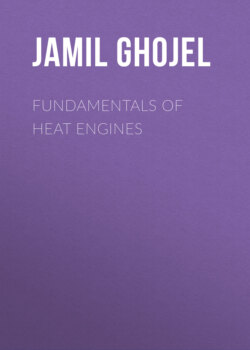Читать книгу Fundamentals of Heat Engines - Jamil Ghojel - Страница 25
1.1.9 Rotational Work, Power, and Kinetic Energy
ОглавлениеIf a rigid body rotates through incremental angle dθ under the action of constant torque T, the incremental rotational work will be
And the rotational power is
(1.21)
Power produced by heat engines is always rotational; hence, subscript r will be dropped henceforward. If the angular velocity of the engine shaft is expressed in terms of rotational speed N in revolutions per minute (rpm), Eq. (1.21) can be rewritten as
(1.22)
The SI unit of power is the watt (W), but the old unit of horsepower (HP) is still widely used, where 1 HP ≡ 0.746 kW.
The kinetic energy of a particle of mass dm (Figure 1.5) is 1/2dm(ωl)2, and the total kinetic energy (KE) for the whole rigid body having a constant angular velocity is
(1.23)
Making use of Eq. (1.19), we can write
(1.24)
Table 1.1 summarises the equations of motion of uniformly accelerating bodies in linear and rotational motion. The following notation is used in the equations:
s, v, and a: linear displacement, velocity, and acceleration
θ, ω, and α: angular displacement, velocity, and acceleration.
Subscripts i and f denote initial and final, respectively.
Table 1.1 Equations of motion for linear and rotational motions.
| Linear | Rotational |
| s = vit + at2/2 | θ = θit + αt2/2 |
| vf = vi + at | θf = θi + αt |
| s = (vi + Vf)t/2 | θ = (ωi + ωf)t/2 |
